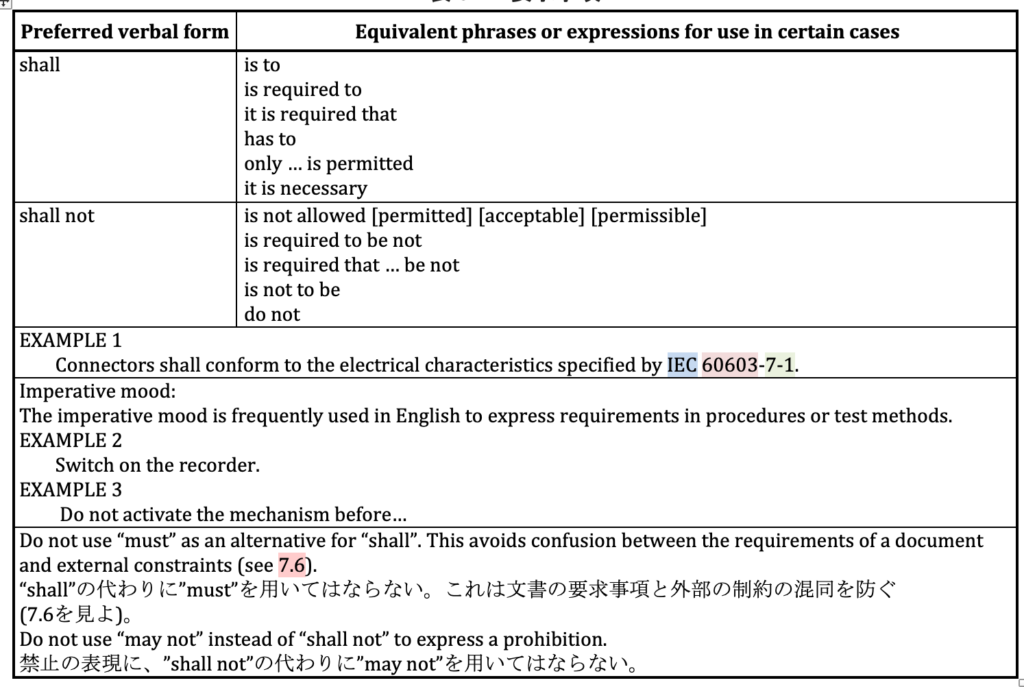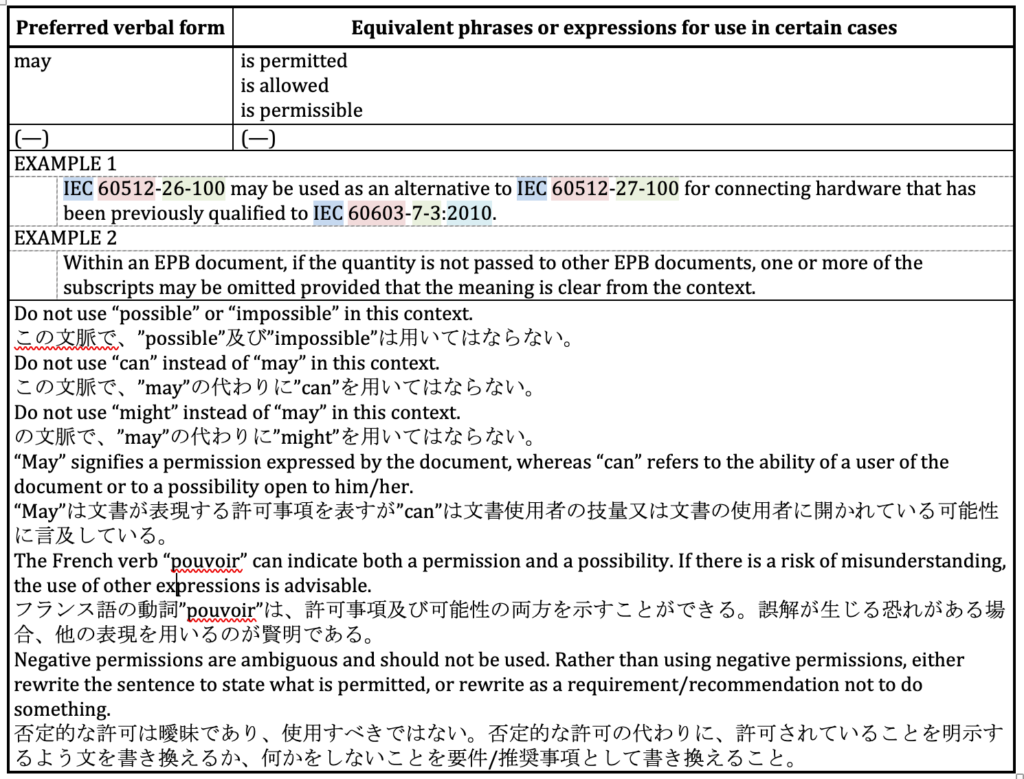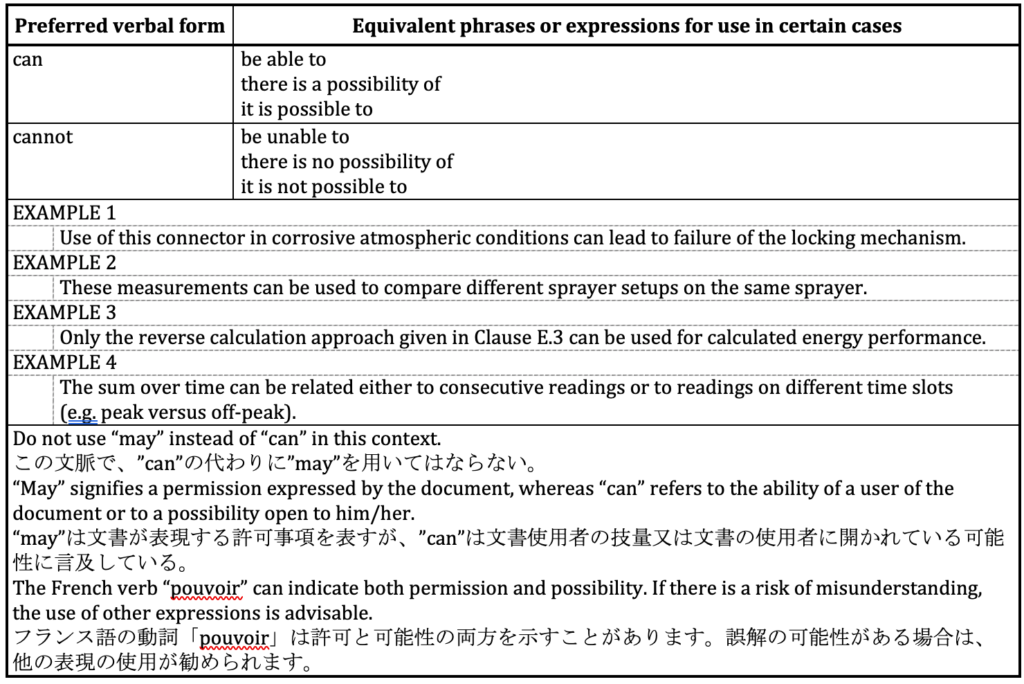規格を読んでいると、文章中にshallやshould、mayなどの表現が出てくることがありますが、私みたいな超が付く英語初心者にとっては、これらの表現がどの程度の強制力を持っているのか理解しづらいところがありました。
そこで、今回、これらの表現がどのように定義されているのかを調べてみました。結果としては、IEC 60601-1-2やISO/IEC Directive, Part 2にてこれらの表現の意味合いについて言及されている個所があります。ご参考ください。
※このブログ記事はいつものとおり内容を保証するものではありませんので詳細は規格原文をご確認ください。
IEC 60601-1-2: 2014における助動詞の定義
当該規格のFOREWORDから以下記載箇所を抜粋しました。
※訳はgoogle翻訳になりますので、参考程度にしてください。
– “shall” means that compliance with a requirement or a test is mandatory for compliance with this collateral standard;
– “shall” は、この付随基準に準拠するために要件またはテストへの準拠が必須であることを意味します。
– “should” means that compliance with a requirement or a test is recommended but is not mandatory for compliance with this collateral standard;
– “should” とは、要件またはテストへの準拠が推奨されるが、この付随基準への準拠が必須ではないことを意味します。
– “may” is used to describe a permissible way to achieve compliance with a requirement or test.
– “may” は、要件またはテストへの準拠を達成するための許容される方法を説明するために使用されます。
※IEC 60601-1-2: 2014 医療用電気機器におけるEMC規格
MEDICAL ELECTRICAL EQUIPMENT – Part 1-2: General requirements for basic safety and essential performance – Collateral Standard: Electromagnetic disturbances – Requirements and tests
ISO/IEC Directives, Part 2 Ninth edition, 2021における助動詞の定義
ISO/IEC Directives, Part 2 Ninth edition, 2021より3項及び7項から以下関係箇所を抜粋しました。
3 Terms and definitions
3 用語及び定義
3.3.3 requirement
3.3.3 要求事項
expression, in the content of a document (3.1.1), that conveys objectively verifiable criteria to be fulfilled and from which no deviation is permitted if conformance with the document is to be claimed
満たすべき客観的な検証可能な基準を示し、文書への適合が要求された場合は逸脱が認められない、文書(3.1.1)の内容における表現
Note 1 to entry: Requirements are expressed using the verbal forms specified in Table 3.
注釈 1: 要求事項は表3に規定された表現形式を用いて表現される。
3.3.4 recommendation
3.3.4 推奨事項
expression, in the content of a document (3.1.1), that conveys a suggested possible choice or course of action deemed to be particularly suitable without necessarily mentioning or excluding others
必ずしも他のものに言及又はそれを排除することなく、特に適切とみなされる、推奨される考え得る選択肢又は措置を示す文書(3.1.1)の内容における表現
Note 1 to entry: Recommendations are expressed using the verbal forms specified in Table 4.
注釈1: 推奨事項は表4に規定された表現形式を用いて表現される。
Note 2 to entry: In the negative form, a recommendation is the expression that a suggested possible choice or course of action is not preferred but it is not prohibited.
注釈2: 否定形の場合、推奨事項は、推奨される考え得る選択肢又は措置を望ましくないが、禁止されていないという表現である。
3.3.5 permission
3.3.5 許可事項
expression, in the content of a document (3.1.1), that conveys consent or liberty (or opportunity) to do something
何かを行うことの承認又は自由(若しくは機会)を示す文書(3.1.1)の内容における表現
Note 1 to entry: Permissions are expressed using the verbal forms specified in Table 5.注釈1: 許可事項は、表5に規定された表現形式を用いて表現される。
3.3.6 possibility
3.3.6可能性
expression, in the content of a document (3.1.1), that conveys expected or conceivable material, physical or causal outcome
予想される、又は考えられる物質的、物理的又は因果的結果を示す文書(3.1.1)の内容における表現
Note 1 to entry: Possibility is expressed using the verbal forms specified in Table 6.
注釈1: 可能性は、表6に規定された表現形式を用いて表現される。
3.3.7 capability
3.3.7能力
expression, in the content of a document (3.1.1), that conveys the ability, fitness, or quality necessary to do or achieve a specified thing
特定のことを実行又は達成するために必要な能力、適性、又は資質を示す文書(3.1.1)の内容における表現
Note 1 to entry: Capability is expressed using the verbal forms specified in Table 6.
注釈1: 能力は、表6に規定された表現形式を用いて表現される。
3.3.8 external constraint
3.3.8 外部の制約
constraint or obligation on the user of the document (3.1.1) (e.g. laws of nature or particular conditions existing in some countries or regions) that is not stated as a provision (3.3.1) of the document
文書の規定(3.3.1)として示されていない、文書(3.1.1)の使用者に課される制約又は義務(例: 自然の法則、又は一部の国若しくは地域に存在する固有の事情)
Note 1 to entry: External constraints are referred to using the verbal form specified in Table 7.
注釈1: 外部の制約は、表7に規定された表現形式を用いて参照される。
Note 2 to entry: Use of the word “must” does not imply that the external constraint referred to is a requirement (3.3.3) of the document.
注釈2: “must”という単語の使用は、参照された外部の制約が文書の要求事項(3.3.3)であることを意味しない。
7 Verbal forms for expressions of provisions
7 規定を表す表現形式
7.2 Requirement
7.2 要求事項
See the definition given in 3.3.3.
3.3.3に定められている定義を見よ。
The verbal forms shown in Table 3 shall be used to express requirements.
要求事項を表現するには、表3に示されている表現形式を使用しなければならい。
Table 3 — Requirement
表3 — 要求事項

7.3 Recommendation
7.3推奨事項
See the definition given in 3.3.4.
3.3.4に定められている定義を見よ。
The verbal forms shown in Table 4 shall be used to express recommendations.
推奨事項を表現するには、表4に示されている表現形式を使用しなければならない。
Table 4 — Recommendation
表4 — 推奨事項

7.4 Permission
7.4許可事項
See the definition given in 3.3.5.
3.3.5に定められている定義を見よ。
The verbal forms shown in Table 5 shall be used to express permission.
許可事項を表現するには、表5に示されている表現形式を使用しなければならない。
Table 5 — Permission
表5 — 許可事項

7.5 Possibility and capability
7.5 可能性及び能力
See the definitions given in 3.3.6 and 3.3.7.
3.3.6及び3.3.7に定められている定義を見よ。
The verbal forms shown in Table 6 shall be used to express possibility and capability.
可能性及び能力を表現するには、表6に示されている表現形式を使用しなければならない。
Table 6 — Possibility and capability
表6 — 可能性及び能力

7.6 External constraint
7.6 外部の制約
See the definition given in 3.3.8.
3.3.6に定められている定義を見よ。
External constraints are not requirements of the document. They are given for the information of the user.
外部の制約は、文書の要求事項ではない。使用者への参考として示される。
The verbal form shown in Table 7 shall be used to indicate constraints or obligations defined outside the document.
表7に示された表現形式は、文書外で定義されている制約又は義務を示すために使用しなければならい。
Table 7 — External constraint
表 7 — 外部の制約

※ISO/IEC Directives, Part 2 Ninth edition, 2021
ISO および IEC 文書の構造と草案に関する原則と規則
Principles and rules for the structure and drafting of ISO and IEC documents
ISO および IEC 文書の構造と草案に関する原則と規則
まとめ
「shall」: 要求事項へ必須であることを意味している。
「should」: 要求事項へ推奨であることを意味します。
「may」: 許容される方法を説明するために使用されます。
その他
「can」: 可能性及び能力を表現するために使用されます。
「must」: 文書外で定義されている制約又は義務を示すために使用される。
と定義されてるようでした。
参考
IEC 60601-1-2: 2014 preview pdfが確認できるHP
https://webstore.iec.ch/publication/2590
ISO/IEC Directives, Part 2 html (Edition 9)
https://www.iso.org/sites/directives/current/part2/index.xhtml



コメント